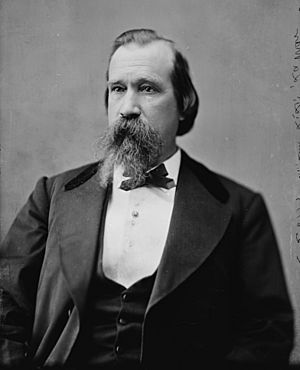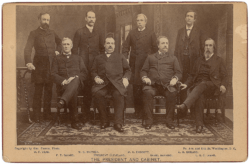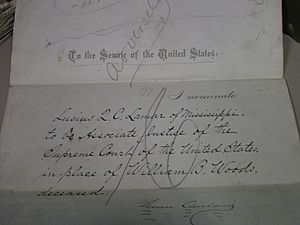Lucius Quintus Cincinnatus Lamar facts for kids
Quick facts for kids
Lucius Quintus Cincinnatus Lamar
|
|
|---|---|
 |
|
| Associate Justice of the Supreme Court of the United States | |
| In office January 18, 1888 – January 23, 1893 |
|
| Nominated by | Grover Cleveland |
| Preceded by | William Burnham Woods |
| Succeeded by | Howell Edmunds Jackson |
| 16th United States Secretary of the Interior | |
| In office March 6, 1885 – January 10, 1888 |
|
| President | Grover Cleveland |
| Preceded by | Henry Teller |
| Succeeded by | William Vilas |
| United States Senator from Mississippi |
|
| In office March 4, 1877 – March 6, 1885 |
|
| Preceded by | James Alcorn |
| Succeeded by | Edward Walthall |
| Chairman of the House Democratic Caucus | |
| In office March 4, 1875 – March 3, 1877 |
|
| Speaker | Michael C. Kerr (1875–1876) Samuel J. Randall (1876–1877) |
| Preceded by | William E. Niblack |
| Succeeded by | Hiester Clymer |
| Member of the U.S. House of Representatives from Mississippi's 1st district |
|
| In office March 4, 1873 – March 3, 1877 |
|
| Preceded by | George Harris |
| Succeeded by | Henry Muldrow |
| In office March 4, 1857 – December 20, 1860 |
|
| Preceded by | Daniel Wright |
| Succeeded by | Vacant 1860–1870; George Harris |
| Personal details | |
| Born | September 17, 1825 Eatonton, Georgia, U.S. |
| Died | January 23, 1893 (aged 67) Vineville, Georgia, U.S. (now Macon) |
| Political party | Democratic |
| Parent |
|
| Education | Emory University (BA) |
| Signature | |
| Military service | |
| Allegiance | |
| Branch/service | |
| Rank | |
| Battles/wars | American Civil War |
Lucius Quintus Cincinnatus Lamar II (September 17, 1825 – January 23, 1893) was an important American politician, diplomat, and judge. He was a member of the Democratic Party. He represented the state of Mississippi in both the House of Representatives and the Senate. He also served as the United States Secretary of the Interior, a top government job. Later, he became an Associate Justice of the Supreme Court of the United States, which is the highest court in the country. He also worked for the Confederate States of America during the American Civil War.
Lamar was born and went to school in Georgia. He later moved to Oxford, Mississippi to start his career as a lawyer. In 1856, he was elected to the U.S. House of Representatives. He served there until 1860, when he helped write Mississippi's plan to leave the United States. During the Civil War, he helped form a military group and worked for a Confederate general. In 1862, the Confederate President, Jefferson Davis, sent Lamar to Russia as a diplomat.
After the Civil War ended, Lamar taught at the University of Mississippi. He also helped write parts of Mississippi's state constitution. He returned to the U.S. House of Representatives in 1873. He was the first Democrat from Mississippi to be elected to the House since the war. He then served in the U.S. Senate from 1877 to 1885. He initially opposed giving voting rights to African Americans. However, he later changed his views and supported black suffrage. In 1885, he became the Secretary of the Interior for President Grover Cleveland. In 1888, he was confirmed as a Supreme Court Justice. He was the first person from the Southern states to join the court after the Civil War. He served on the court until he passed away in 1893.
Contents
Early Life and Education
Lucius Lamar was born on September 17, 1825, in Eatonton, Georgia. His parents were Lucius Quintus Cincinnatus Lamar and Sarah Williamson Bird. He was related to other important people. His cousin, Joseph Rucker Lamar, also became a Supreme Court Justice. His uncle, Mirabeau B. Lamar, was the second president of the Republic of Texas.
In 1845, Lamar graduated from Emory College, which is now Emory University. He was part of a student group called Sigma Alpha Epsilon. He was also one of the first members of this group's chapter at the University of Mississippi.
After college, Lamar married Virginia Longstreet. Her father, Augustus Baldwin Longstreet, moved to Oxford, Mississippi in 1849. He became the leader of the new University of Mississippi. Lamar followed him and worked as a math professor for one year. He also worked as a lawyer in Oxford. Later, he became a planter, which meant he owned a large farm called Solitude. On this farm, located near Abbeville, he grew cotton and owned many enslaved people.
In 1852, Lamar moved to Covington, Georgia, and continued his law practice. He became involved with the Democratic Party. In 1853, he was elected to the Georgia House of Representatives. In 1855, he moved back to Mississippi.
Political Career and the Civil War
In 1855, Lamar and his family returned to Mississippi. He was elected to the U.S. House of Representatives in 1856 and started his service in 1857. In December 1860, Lamar left the House to join Mississippi's Secession Convention. This group decided if Mississippi would leave the United States. Lamar helped write the state's official document to leave the Union.
When Mississippi declared it had left the U.S. and joined the Confederacy on January 9, 1861, Lamar spoke about it. He said he looked forward to a time when the Confederacy would be a country worth living and dying for.
Lamar helped create the 19th Mississippi Infantry Regiment and paid for some of its needs himself. He was commissioned as a lieutenant colonel. On May 15, 1862, Lamar had a dizzy spell while reviewing his regiment. This health issue ended his military service.
After this, he worked as a legal advisor and helper for his wife's cousin, General James Longstreet. Later in 1862, Confederate President Jefferson Davis appointed Lamar as a diplomat. He was sent to Russia and also worked as a special envoy to the United Kingdom and France.
When the Civil War ended, Lamar went back to the University of Mississippi. He taught subjects like philosophy, social science, and law. He also participated in several of Mississippi's meetings to change its constitution between 1865 and 1881.
Later Public Service
After the Civil War, Lamar's rights as a citizen were restored. He returned to the U.S. House of Representatives in 1873. He was the first Democrat from Mississippi to be elected to the House since the war ended. He served there until 1877. Then, the state legislature elected him to represent Mississippi in the U.S. Senate. He served as a Senator from 1877 to 1885.
Lamar strongly opposed the period called Reconstruction. This was a time after the Civil War when the U.S. government tried to rebuild the Southern states and protect the rights of newly freed African Americans. Lamar initially believed that African Americans were not ready to vote. However, he later changed his mind and supported their right to vote. He also opposed the 1890 Mississippi Constitution, which made it harder for black citizens to vote.
In 1885, President Grover Cleveland chose Lamar to be the United States Secretary of the Interior. This department manages many important things like national parks and public lands. Lamar was the first Democrat in this role in 24 years. Many people came to him asking for government jobs. One day, a visitor came who wasn't asking for a job. Lamar asked him to stay. He said, "You rest me. I can look at you, and you do not ask me for anything; and you keep those people out as long as you stay in." This shows how many people were seeking jobs from him.
Lamar was known for being open to appointing African Americans to government jobs. As Secretary, he also stopped using the department's fancy carriages for officials. He only used his own simple, one-horse carriage.
Supreme Court Justice
On December 6, 1887, President Cleveland nominated Lamar to become an Associate Justice of the Supreme Court of the United States. This meant he would be one of the nine judges on the highest court. The U.S. Senate approved Lamar's nomination by a vote of 32 to 28 on January 16, 1888. He officially started his job two days later. He was the first Supreme Court Justice from the Southern states appointed after the Civil War. He served on the court until he died.
Lamar passed away on January 23, 1893, in Vineville, Georgia. He was first buried in Macon, Georgia. But in 1894, his body was moved to St. Peter's Cemetery in Oxford, Mississippi.
Places Named After Lamar
Many places are named in honor of Lucius Q. C. Lamar:
- During a survey in 1884–85, a geologist named a part of the Yellowstone River in Yellowstone National Park the Lamar River. The Lamar Valley and other features in the park are also named after him.
- Lamar Hall at the University of Mississippi in Oxford is named for him.
- Lamar Avenue, a main road in Oxford, Mississippi, also carries his name.
- The L.Q.C. Lamar House in Oxford, Mississippi, is a National Historic Landmark. It is now a museum and park.
- Lamar School in Meridian, Mississippi, is named after him.
- The Lamar Bathhouse in Hot Springs National Park is named for him.
In 2022, Emory University removed Lamar's name from two professorships in its law school. This was done because of his strong support for slavery in the past.
Legacy and Honors
Three counties in the United States are named after Lucius Q. C. Lamar:
Some towns, like Lamar, Wisconsin, and Colorado, are also named for him. Additionally, roads like Lamar Blvd in Oxford and Lamar Avenue in Memphis bear his name.
Lamar was featured in the book Profiles in Courage (1957) by John F. Kennedy. The book highlighted his famous speech about Massachusetts Senator Charles Sumner in 1874. It also mentioned his support for the findings of a committee about the disputed 1876 United States presidential election.
Images for kids



